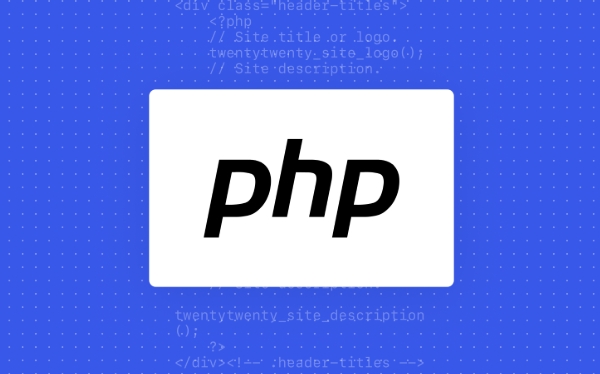 Backend Development
Backend Development
 PHP Tutorial
PHP Tutorial
 The Duality of PHP: Navigating Loose Typing vs. Strict Type Declarations
The Duality of PHP: Navigating Loose Typing vs. Strict Type Declarations
The Duality of PHP: Navigating Loose Typing vs. Strict Type Declarations
Jul 26, 2025 am 09:42 AMPHP supports the coexistence of loose types and strict types, which is the core feature of its evolution from scripting languages to modern programming languages. 1. Loose types are suitable for rapid prototyping, handling dynamic user input, or docking with external APIs, but there are problems such as risk of implicit type conversion, difficulty in debugging and weak tool support. 2. Strict type is enabled by declare(strict_types=1), which can detect errors in advance, improve code readability and IDE support, and is suitable for scenarios with high requirements for core business logic, team collaboration and data integrity. 3. Mixed use should be used in actual development: strict types are enabled by default, loose types are used only when necessary at the input boundaries, and verification and type conversion are performed as soon as possible. 4. Recommended practices include using PHPStan or Psalm for static analysis, using PHP 8 joint types and nullable types to enhance declaration accuracy, and explicitly annotate reasons when bypassing strict types. 5. The best strategy is to build a stable kernel with strict types, use loose types to deal with external interaction edges, and achieve a balance of flexibility and reliability. This is exactly the power of modern PHP.

PHP's evolution over the years has made it a language of contrasts — perhaps most notably in the tension between its roots in loose (dynamic) typing and the modern push towards strict type declarations. This duality isn't a flaw; it's a feature of PHP's pragmatic design, offering flexibility for rapid development while allowing structure for maintainable, scalable applications. Navigating this balance is key to writing robust PHP code in 2024 and beyond.

Loose Typing: Flexibility at a Cost
PHP was born as a loosely typed language, meaning variables don't need predefined types, and type coercion happens automatically.
function add($a, $b) {
return $a $b;
}
echo add("5", "3"); // 8
echo add("5 apples", 3); // 8 (because "5 apples" becomes 5)This flexibility allows for fast prototype and dynamic behavior, but it comes with risks:

- Unexpected type juggling :
"5 apples"becomes5, which might mask bugs. - Harder debugging : Type-related issues surface at runtime, not during development.
- Poor IDE support : Without type hints, auto-completion and refactoring are limited.
Loose typing works well for small scripts or simple web forms, but it becomes a liability in larger applications where predictability matters.
Strict Type Declarations: Bringing Predictability
Starting with PHP 7.0, the language introduced scalar type declarations and return type hints. With declare(strict_types=1); , you can enforce strict type checking within a file.

declare(strict_types=1);
function add(int $a, int $b): int {
return $a $b;
}
echo add(5, 3); // 8
echo add("5", "3"); // TypeError: Argument 1 must be of type intStrict typing brings several advantages:
- Early error detection : Type mismatches throw errors immediately.
- Better code documentation : Function signatures clearly state expectations.
- Improved tooling : IDEs can provide better autocomplete and static analysis.
However, strict typing isn't a magic bullet. It requires discipline and thoughtful adoption.
When to Use Each Approach
The real skill lies in knowing when to lean into flexibility and when to enforce structure.
Use loose typing when:
- Building quick prototypes or simple utilities.
- Working with user input that's inherently dynamic.
- Interfacing with legacy code or external APIs with inconsistent data.
Use strict typing when:
- Developing core business logic or reusable libraries.
- Working in a team where clarity and consistency are cruel.
- Building APIs or services where data integrity is non-negotiable.
You don't have to choose one style for the entire project. Modern PHP applications often mix both:
- Use strict types in domain models and service layers.
- Allow loose types at input boundaries (eg, controllers), then validate and cast early.
Practical Tips for Balancing Both Worlds
To make the most of PHP's duality, consider these practices:
- Enable
strict_types=1by default in new files. Opt out only when necessary. - Validate and sanitize input early . Convert loose input into well-typed domain objects.
- Use PHPStan or Psalm for static analysis — they catch type issues even in loosely typed code.
- Leverage union types (PHP 8.0) and
nullabletypes for more precise declarations:function findUser(int|string $id): ?User { ... } - Document assumptions when bypassing strict typing — make it clear why flexibility is needed.
The duality of loose vs. strict typing in PHP reflects its journey from a simple scripting tool to a mature language for modern web development. Rather than seeing these as opposed forces, treat them as comprehensive tools. Use strict typing to build a solid, predictable core, and allow loose typing at the edges where flexibility is needed. That balance is where PHP shines today.
The above is the detailed content of The Duality of PHP: Navigating Loose Typing vs. Strict Type Declarations. For more information, please follow other related articles on the PHP Chinese website!

Hot AI Tools

Undress AI Tool
Undress images for free

Undresser.AI Undress
AI-powered app for creating realistic nude photos

AI Clothes Remover
Online AI tool for removing clothes from photos.

Clothoff.io
AI clothes remover

Video Face Swap
Swap faces in any video effortlessly with our completely free AI face swap tool!

Hot Article

Hot Tools

Notepad++7.3.1
Easy-to-use and free code editor

SublimeText3 Chinese version
Chinese version, very easy to use

Zend Studio 13.0.1
Powerful PHP integrated development environment

Dreamweaver CS6
Visual web development tools

SublimeText3 Mac version
God-level code editing software (SublimeText3)
 Modernizing Your Codebase with PHP 8's Union Types
Jul 27, 2025 am 04:33 AM
Modernizing Your Codebase with PHP 8's Union Types
Jul 27, 2025 am 04:33 AM
UpgradePHP7.xcodebasestoPHP8 byreplacingPHPDoc-suggestedtypeslike@paramstring|intwithnativeuniontypessuchasstring|intforparametersandreturntypes,whichimprovestypesafetyandclarity;2.Applyuniontypestomixedinputparameters(e.g.,int|stringforIDs),nullable
 The Duality of PHP: Navigating Loose Typing vs. Strict Type Declarations
Jul 26, 2025 am 09:42 AM
The Duality of PHP: Navigating Loose Typing vs. Strict Type Declarations
Jul 26, 2025 am 09:42 AM
PHP supports the coexistence of loose types and strict types, which is the core feature of its evolution from scripting languages to modern programming languages. 1. Loose types are suitable for rapid prototyping, handling dynamic user input, or docking with external APIs, but there are problems such as risk of implicit type conversion, difficulty in debugging and weak tool support. 2. Strict type is enabled by declare(strict_types=1), which can detect errors in advance, improve code readability and IDE support, and is suitable for scenarios with high requirements for core business logic, team collaboration and data integrity. 3. Mixed use should be used in actual development: Strict types are enabled by default, loose types are used only when necessary at the input boundaries, and verification and type conversion are performed as soon as possible. 4. Recommended practices include using PHPSta
 PHP 8.1 Enums: A New Paradigm for Type-Safe Constants
Jul 28, 2025 am 04:43 AM
PHP 8.1 Enums: A New Paradigm for Type-Safe Constants
Jul 28, 2025 am 04:43 AM
Enums introduced in PHP8.1 provides a type-safe constant collection, solving the magic value problem; 1. Use enum to define fixed constants, such as Status::Draft, to ensure that only predefined values are available; 2. Bind enums to strings or integers through BackedEnums, and support conversion from() and tryFrom() between scalars and enums; 3. Enums can define methods and behaviors, such as color() and isEditable(), to enhance business logic encapsulation; 4. Applicable to static scenarios such as state and configuration, not for dynamic data; 5. It can implement the UnitEnum or BackedEnum interface for type constraints, improve code robustness and IDE support, and is
 Understanding the `callable` Pseudo-Type and Its Implementation
Jul 27, 2025 am 04:29 AM
Understanding the `callable` Pseudo-Type and Its Implementation
Jul 27, 2025 am 04:29 AM
AcallableinPHPisapseudo-typerepresentinganyvaluethatcanbeinvokedusingthe()operator,usedprimarilyforflexiblecodeincallbacksandhigher-orderfunctions;themainformsofcallablesare:1)namedfunctionslike'strlen',2)anonymousfunctions(closures),3)objectmethodsv
 The Perils of Precision: Handling Floating-Point Numbers in PHP
Jul 26, 2025 am 09:41 AM
The Perils of Precision: Handling Floating-Point Numbers in PHP
Jul 26, 2025 am 09:41 AM
0.1 0.2!==0.3inPHPduetobinaryfloating-pointprecisionlimitations,sodevelopersmustavoiddirectcomparisonsanduseepsilon-basedchecks,employBCMathorGMPforexactarithmetic,storecurrencyinintegerswhenpossible,formatoutputcarefully,andneverrelyonfloatprecision
 Resource Management in PHP: The Lifecycle of a `resource` Type
Jul 27, 2025 am 04:30 AM
Resource Management in PHP: The Lifecycle of a `resource` Type
Jul 27, 2025 am 04:30 AM
The life cycle of PHP resources is divided into three stages: 1. Resource creation, obtaining external system handles through functions such as fopen and curl_init; 2. Resource usage, passing resources to related functions for operation, PHP maps to the underlying system structure through resource ID; 3. Resource destruction, manually calling fclose, curl_close and other functions should be given priority to release resources to avoid relying on automatic garbage collection to prevent file descriptors from exhausting. Best practices include: always explicitly close resources, use try... finally ensure cleanup, prioritize objects such as PDO that supports __destruct, avoid global storage resources, and monitor active resources through get_resources()
 The Life of a Variable: PHP's Internal `zval` Structure Explained
Jul 27, 2025 am 03:47 AM
The Life of a Variable: PHP's Internal `zval` Structure Explained
Jul 27, 2025 am 03:47 AM
PHP uses zval structure to manage variables. The answer is: 1. zval contains values, types and metadata, with a size of 16 bytes; 2. When the type changes, only the union and type information need to be updated; 3. Complex types refer to structures with reference counts through pointers; 4. When assigning values, copy is used to optimize memory; 5. References make variables share the same zval; 6. Recycling references are processed by a special garbage collector. This explains the underlying mechanism of PHP variable behavior.
 Unraveling PHP's Type Juggling: A Guide to `==` vs. `===`
Jul 28, 2025 am 04:40 AM
Unraveling PHP's Type Juggling: A Guide to `==` vs. `===`
Jul 28, 2025 am 04:40 AM
==performsloosecomparisonwithtypejuggling,===checksbothvalueandtypestrictly;1."php"==0istruebecausenon-numericstringsconvertto0,2.emptystrings,null,false,and0arelooselyequal,3.scientificnotationlike"0e123"=="0e456"cancau





